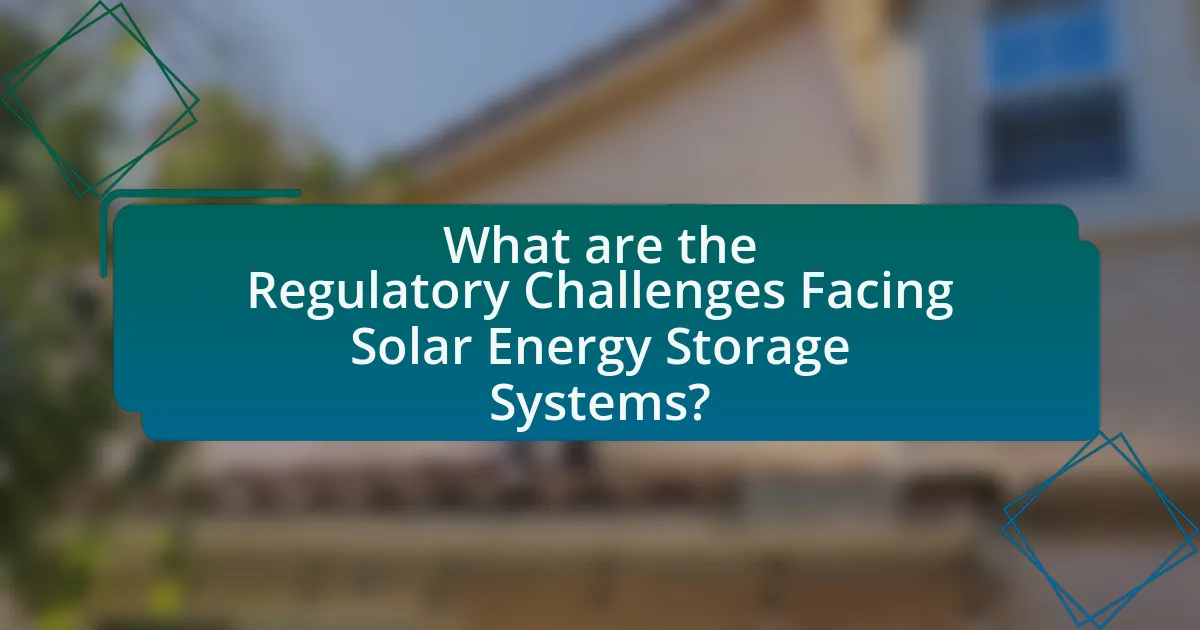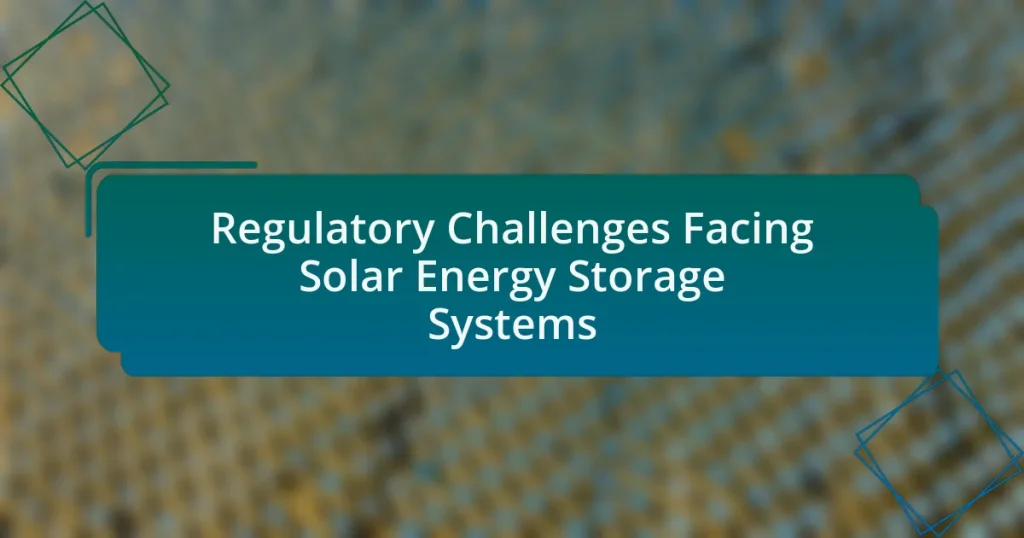The article addresses the regulatory challenges facing solar energy storage systems, highlighting issues such as inconsistent policies, varying interconnection standards, and complex permitting processes that hinder investment and deployment. It examines the impact of regulations on the development of these systems, detailing specific regulations like FERC Order 841 and state-level incentives that shape market dynamics. The article also discusses the importance of regulatory compliance for safety and environmental protection, the role of industry associations, and strategies for stakeholders to navigate these challenges effectively. Additionally, it explores emerging trends in regulatory frameworks and the potential future challenges that may arise from evolving regulations.
What are the Regulatory Challenges Facing Solar Energy Storage Systems?


Regulatory challenges facing solar energy storage systems include inconsistent policies, interconnection standards, and permitting processes. Inconsistent policies across different states and regions create uncertainty for developers, hindering investment and deployment. Interconnection standards often vary, complicating the integration of storage systems with existing grid infrastructure. Additionally, lengthy and complex permitting processes can delay project timelines, increasing costs and reducing the feasibility of solar energy storage initiatives. These challenges are documented in reports from organizations such as the National Renewable Energy Laboratory, which highlight the need for streamlined regulations to support the growth of solar energy storage.
How do regulations impact the development of solar energy storage systems?
Regulations significantly influence the development of solar energy storage systems by establishing standards, incentives, and barriers that shape market dynamics. For instance, regulations can mandate safety and performance standards, ensuring that storage systems meet specific technical requirements, which can enhance consumer confidence and drive adoption. Additionally, financial incentives such as tax credits or rebates can stimulate investment in solar storage technologies, as seen in the U.S. where the Investment Tax Credit has been pivotal in promoting solar energy growth. Conversely, restrictive regulations, such as interconnection standards or permitting processes, can hinder the deployment of these systems by increasing costs and complexity. Therefore, the regulatory landscape plays a crucial role in either facilitating or obstructing the advancement of solar energy storage solutions.
What specific regulations affect solar energy storage technologies?
Specific regulations affecting solar energy storage technologies include the Federal Energy Regulatory Commission (FERC) Order 841, which mandates that grid operators allow energy storage resources to participate in wholesale electricity markets. Additionally, state-level regulations vary, with some states implementing net metering policies that impact how energy storage systems are compensated for energy fed back into the grid. Furthermore, safety and performance standards set by organizations such as Underwriters Laboratories (UL) and the National Fire Protection Association (NFPA) also play a crucial role in regulating the deployment and operation of solar energy storage technologies. These regulations collectively ensure that energy storage systems are integrated effectively and safely into the energy grid.
How do local, state, and federal regulations differ in their approach?
Local, state, and federal regulations differ significantly in their approach to solar energy storage systems. Local regulations often focus on zoning laws, permitting processes, and building codes that directly impact the installation of solar energy systems within specific communities. State regulations typically establish broader policies, incentives, and standards for renewable energy, including net metering and interconnection rules that facilitate the integration of solar energy into the grid. Federal regulations, on the other hand, provide overarching guidelines and funding opportunities, such as tax credits and grants, aimed at promoting renewable energy technologies on a national scale. For instance, the federal Investment Tax Credit (ITC) offers a significant tax incentive for solar installations, which is not typically available at the local or state level.
Why is regulatory compliance important for solar energy storage systems?
Regulatory compliance is crucial for solar energy storage systems because it ensures safety, reliability, and environmental protection. Compliance with regulations helps mitigate risks associated with battery storage, such as fire hazards and chemical leaks, thereby protecting both users and the environment. For instance, adherence to standards set by organizations like Underwriters Laboratories (UL) and the National Fire Protection Association (NFPA) provides guidelines that enhance the safety of energy storage installations. Furthermore, regulatory compliance can facilitate access to incentives and funding opportunities, as many government programs require adherence to specific standards to qualify for financial support.
What are the consequences of non-compliance with regulations?
Non-compliance with regulations can lead to significant legal and financial consequences for solar energy storage systems. Entities that fail to adhere to regulatory standards may face hefty fines, which can range from thousands to millions of dollars depending on the severity of the violation. Additionally, non-compliance can result in the suspension or revocation of operating licenses, effectively halting business operations. For instance, the U.S. Environmental Protection Agency has imposed penalties exceeding $1 billion for violations related to energy regulations. Furthermore, non-compliance can damage a company’s reputation, leading to loss of customer trust and potential market share.
How can companies ensure they meet regulatory requirements?
Companies can ensure they meet regulatory requirements by implementing a comprehensive compliance management system. This system should include regular audits, employee training on regulatory standards, and the establishment of clear policies and procedures that align with local, state, and federal regulations. For instance, the Solar Energy Industries Association (SEIA) emphasizes the importance of understanding and adhering to the National Electrical Code (NEC) and other relevant standards to avoid penalties and ensure safety. Additionally, maintaining open communication with regulatory bodies and staying updated on changes in legislation can further enhance compliance efforts.
What role do incentives and subsidies play in regulatory challenges?
Incentives and subsidies significantly influence regulatory challenges by shaping market dynamics and investment decisions in solar energy storage systems. These financial mechanisms can encourage the adoption of renewable technologies, but they may also lead to regulatory complexities, such as compliance with varying state and federal requirements. For instance, the federal Investment Tax Credit (ITC) has spurred growth in solar installations, yet it necessitates ongoing adjustments in regulatory frameworks to accommodate the influx of new technologies and market participants. Additionally, subsidies can create disparities in competition, prompting regulatory bodies to address issues of fairness and market access.
How do financial incentives influence the adoption of solar energy storage?
Financial incentives significantly enhance the adoption of solar energy storage by reducing the initial investment costs for consumers. These incentives, such as tax credits, rebates, and grants, lower the financial barrier, making solar energy storage systems more accessible. For instance, the Federal Investment Tax Credit (ITC) allows homeowners to deduct a percentage of the cost of solar systems from their federal taxes, which has been shown to increase installation rates. According to a report by the Solar Energy Industries Association, the ITC contributed to a 167% increase in solar installations from 2016 to 2020. Thus, financial incentives play a crucial role in promoting the widespread adoption of solar energy storage technologies.
What are the challenges associated with changing incentive structures?
Changing incentive structures presents several challenges, including resistance from stakeholders, misalignment of interests, and potential unintended consequences. Stakeholders, such as utility companies and consumers, may resist changes due to fear of increased costs or reduced benefits. Misalignment occurs when new incentives do not align with the goals of all parties involved, leading to conflicts and inefficiencies. Additionally, unintended consequences can arise, such as market distortions or reduced investment in solar energy storage systems, which can undermine the intended benefits of the new incentive structure. These challenges highlight the complexity of modifying incentive frameworks in the context of solar energy storage systems.
What are the Key Regulatory Frameworks for Solar Energy Storage?


The key regulatory frameworks for solar energy storage include the Federal Energy Regulatory Commission (FERC) Order 841, which mandates that grid operators allow energy storage resources to participate in wholesale electricity markets, and state-level policies such as California’s Self-Generation Incentive Program (SGIP), which provides financial incentives for energy storage systems. These frameworks are designed to enhance the integration of energy storage into the grid, promote renewable energy use, and ensure fair market access for storage technologies. FERC Order 841, implemented in 2018, specifically addresses barriers to storage participation, while SGIP has allocated over $1 billion since its inception to support energy storage projects in California, demonstrating the effectiveness of these regulatory measures.
What are the main regulatory bodies overseeing solar energy storage systems?
The main regulatory bodies overseeing solar energy storage systems include the Federal Energy Regulatory Commission (FERC) in the United States, the California Public Utilities Commission (CPUC), and the International Electrotechnical Commission (IEC). FERC regulates interstate electricity sales and transmission, which includes policies affecting energy storage. CPUC oversees utility regulations in California, a leader in solar energy and storage initiatives. IEC develops international standards for electrical technologies, including energy storage systems, ensuring safety and interoperability. These organizations play crucial roles in shaping the regulatory landscape for solar energy storage.
How do these regulatory bodies influence industry standards?
Regulatory bodies influence industry standards by establishing guidelines and requirements that govern the design, safety, and performance of solar energy storage systems. These organizations, such as the National Renewable Energy Laboratory and the International Electrotechnical Commission, create standards that ensure products meet safety and efficiency benchmarks, thereby promoting consumer confidence and market stability. For example, the Underwriters Laboratories (UL) has developed safety standards for energy storage systems, which manufacturers must comply with to sell their products in various markets. This regulatory framework not only drives innovation but also ensures that the technology adheres to safety protocols, ultimately shaping the industry’s operational landscape.
What is the role of international regulations in local markets?
International regulations play a crucial role in shaping local markets by establishing standards that ensure safety, efficiency, and environmental protection. These regulations facilitate cross-border trade, promote fair competition, and encourage investment in local industries. For instance, the International Electrotechnical Commission (IEC) sets global standards for solar energy technologies, which local markets adopt to ensure compliance and enhance product reliability. This alignment with international standards can lead to increased consumer confidence and market growth, as evidenced by the rise in solar energy adoption in regions that adhere to such regulations.
How do safety and environmental regulations affect solar energy storage?
Safety and environmental regulations significantly impact solar energy storage by establishing standards that ensure the safe operation and environmental sustainability of storage systems. These regulations dictate the materials used in batteries, such as lithium-ion, to minimize hazardous waste and promote recycling, thereby reducing environmental risks. For instance, the U.S. Environmental Protection Agency (EPA) enforces regulations that require proper disposal and recycling of battery components, which directly influences the design and lifecycle management of solar energy storage solutions. Compliance with these regulations can also affect the cost and feasibility of implementing solar energy storage systems, as manufacturers must invest in technologies that meet safety standards, such as fire safety protocols and chemical handling procedures.
What safety standards must solar energy storage systems comply with?
Solar energy storage systems must comply with safety standards such as UL 9540, which outlines safety requirements for energy storage systems, and IEC 62619, which specifies safety requirements for battery systems. These standards ensure the safe operation, installation, and maintenance of solar energy storage systems, addressing risks such as fire, electrical hazards, and chemical exposure. Compliance with these standards is critical for manufacturers and installers to mitigate potential safety issues and protect users.
How do environmental regulations impact the lifecycle of storage systems?
Environmental regulations significantly influence the lifecycle of storage systems by imposing standards that affect design, manufacturing, operation, and disposal. These regulations often require storage systems to meet specific environmental performance criteria, such as energy efficiency and emissions reductions, which can lead to increased initial costs and design complexities. For instance, regulations like the Resource Conservation and Recovery Act (RCRA) in the United States mandate proper disposal and recycling of hazardous materials, impacting the end-of-life management of storage systems. Compliance with such regulations can drive innovation in materials and technologies, ultimately enhancing the sustainability of storage systems throughout their lifecycle.
What are the emerging trends in regulatory frameworks for solar energy storage?
Emerging trends in regulatory frameworks for solar energy storage include the integration of performance-based incentives, streamlined permitting processes, and the establishment of standardized interconnection protocols. These trends aim to enhance the deployment of solar energy storage systems by reducing barriers and promoting efficiency. For instance, performance-based incentives are increasingly being adopted to encourage energy storage systems to deliver reliable services, while streamlined permitting processes are being implemented in various jurisdictions to expedite project approvals. Additionally, standardized interconnection protocols are being developed to facilitate easier connections between storage systems and the grid, ensuring compatibility and safety. These regulatory advancements are supported by growing recognition of the role of energy storage in achieving renewable energy targets and enhancing grid resilience.
How are regulations evolving to accommodate new technologies?
Regulations are evolving to accommodate new technologies by increasingly incorporating flexible frameworks that allow for innovation while ensuring safety and compliance. For instance, many jurisdictions are adopting performance-based regulations that focus on the outcomes of technology rather than prescriptive measures, enabling solar energy storage systems to integrate more seamlessly into existing energy infrastructures. Additionally, regulatory bodies are engaging with stakeholders, including technology developers and industry experts, to create guidelines that reflect the rapid advancements in solar energy storage, such as battery technology and grid integration. This collaborative approach is evident in initiatives like the U.S. Department of Energy’s Energy Storage Grand Challenge, which aims to streamline regulatory processes and promote the deployment of energy storage solutions.
What future challenges might arise from these regulatory changes?
Future challenges arising from regulatory changes in solar energy storage systems include compliance costs, technological adaptation, and market access barriers. Compliance costs may increase as new regulations require additional reporting and monitoring, which can strain resources for companies. Technological adaptation challenges may emerge as firms need to innovate or modify existing systems to meet updated standards, potentially leading to delays in deployment. Market access barriers could arise if regulations favor certain technologies or providers, limiting competition and hindering the growth of diverse energy solutions. These challenges are supported by trends indicating that regulatory shifts often lead to increased operational complexities and financial burdens for stakeholders in the renewable energy sector.
What Strategies Can Address Regulatory Challenges in Solar Energy Storage?


To address regulatory challenges in solar energy storage, stakeholders can implement strategies such as advocating for policy reforms, engaging in stakeholder collaboration, and utilizing technology for compliance. Advocating for policy reforms involves working with legislators to create supportive regulations that facilitate the integration of solar energy storage into the grid. Engaging in stakeholder collaboration includes forming partnerships among utilities, government agencies, and industry players to share best practices and develop standardized regulations. Utilizing technology for compliance can streamline reporting and monitoring processes, ensuring adherence to regulations while enhancing operational efficiency. These strategies are essential for overcoming the complex regulatory landscape that solar energy storage systems face.
How can stakeholders collaborate to navigate regulatory challenges?
Stakeholders can collaborate to navigate regulatory challenges by forming coalitions that advocate for common interests and share resources. These coalitions can facilitate communication between industry players, policymakers, and regulatory bodies, ensuring that all parties are informed about the latest developments and challenges in solar energy storage regulations. For instance, the Solar Energy Industries Association (SEIA) has successfully united various stakeholders to influence legislation and regulatory frameworks, demonstrating the effectiveness of collective action. By pooling expertise and data, stakeholders can also develop best practices and compliance strategies that address regulatory requirements while promoting innovation in solar energy storage systems.
What role do industry associations play in shaping regulations?
Industry associations play a crucial role in shaping regulations by advocating for policies that benefit their members and the industry as a whole. These associations engage in lobbying efforts, providing expertise and data to policymakers, which can influence the development of regulations. For instance, the Solar Energy Industries Association (SEIA) has been instrumental in promoting favorable solar policies and incentives, contributing to the growth of the solar energy sector. Their involvement often includes drafting policy proposals, conducting research, and mobilizing member companies to support regulatory initiatives, thereby ensuring that the interests of the industry are represented in the regulatory process.
How can public-private partnerships enhance regulatory compliance?
Public-private partnerships can enhance regulatory compliance by fostering collaboration between government entities and private sector stakeholders, leading to improved adherence to regulations. These partnerships facilitate the sharing of resources, expertise, and information, which can streamline compliance processes and ensure that both parties are aligned with regulatory requirements. For instance, in the solar energy sector, partnerships can help develop standardized compliance frameworks that are easier for companies to follow, ultimately reducing the risk of non-compliance. Additionally, successful public-private partnerships often include mechanisms for ongoing dialogue and feedback, allowing for adaptive regulatory approaches that respond to industry innovations and challenges.
What best practices can companies adopt to manage regulatory risks?
Companies can adopt several best practices to manage regulatory risks effectively. First, they should establish a comprehensive compliance program that includes regular training for employees on relevant regulations and policies. This program should be updated frequently to reflect changes in laws and regulations, ensuring that all staff are aware of their responsibilities.
Additionally, companies should conduct regular risk assessments to identify potential regulatory challenges specific to solar energy storage systems. By analyzing these risks, organizations can develop targeted strategies to mitigate them.
Furthermore, maintaining open communication with regulatory bodies can help companies stay informed about upcoming changes and foster a collaborative relationship. Engaging with industry associations can also provide valuable insights and resources for navigating regulatory landscapes.
Lastly, implementing robust documentation and reporting practices ensures that companies can demonstrate compliance and respond effectively to any inquiries or audits from regulatory authorities. These practices collectively enhance a company’s ability to manage regulatory risks in the solar energy storage sector.
How can companies stay informed about regulatory changes?
Companies can stay informed about regulatory changes by subscribing to industry newsletters, attending relevant conferences, and engaging with regulatory bodies. These methods provide timely updates on new regulations and compliance requirements. For instance, organizations like the Solar Energy Industries Association (SEIA) regularly publish updates and analysis on regulatory developments affecting solar energy. Additionally, utilizing compliance management software can help track changes in regulations specific to solar energy storage systems, ensuring that companies remain compliant and informed.
What tools and resources are available for compliance management?
Compliance management tools and resources include software solutions, regulatory databases, and training programs. Software solutions like GRC (Governance, Risk, and Compliance) platforms help organizations automate compliance processes, track regulations, and manage risks effectively. Regulatory databases, such as LexisNexis and Westlaw, provide access to up-to-date legal information and compliance requirements. Additionally, training programs and certifications, such as those offered by the Compliance Certification Board, equip professionals with the necessary knowledge to navigate compliance challenges. These resources collectively enhance an organization’s ability to meet regulatory requirements efficiently.
What practical steps can be taken to improve regulatory outcomes?
To improve regulatory outcomes for solar energy storage systems, stakeholders should implement clear guidelines and standards that facilitate compliance and innovation. Establishing a framework that defines performance metrics, safety protocols, and interconnection requirements can streamline the regulatory process. For instance, the National Renewable Energy Laboratory has highlighted that standardized testing procedures can reduce uncertainty and enhance market confidence, leading to faster approvals and deployment of solar storage technologies. Additionally, engaging with industry experts and stakeholders during the regulatory development process ensures that regulations are practical and reflective of current technological advancements. This collaborative approach can lead to more effective regulations that support the growth of solar energy storage systems.
How can companies engage with regulators effectively?
Companies can engage with regulators effectively by establishing open lines of communication and actively participating in regulatory processes. This involves regularly meeting with regulatory bodies to discuss industry developments, providing feedback on proposed regulations, and sharing data that supports the benefits of solar energy storage systems. For instance, companies can present case studies demonstrating how their technologies comply with safety and environmental standards, thereby fostering trust and collaboration. Engaging in public consultations and industry forums also allows companies to voice their perspectives and influence regulatory frameworks, which is crucial in a rapidly evolving sector like solar energy.
What are the common pitfalls to avoid in regulatory compliance?
Common pitfalls to avoid in regulatory compliance include inadequate understanding of regulations, lack of documentation, and failure to engage stakeholders. Inadequate understanding can lead to non-compliance with specific requirements, as regulations often contain complex language and stipulations that require thorough interpretation. Lack of documentation can result in difficulties during audits or inspections, as organizations may not have the necessary records to demonstrate compliance. Additionally, failure to engage stakeholders, such as regulatory bodies and community members, can lead to misunderstandings and resistance, ultimately hindering compliance efforts. These pitfalls are critical to address, as they can result in legal penalties, financial losses, and damage to reputation.


